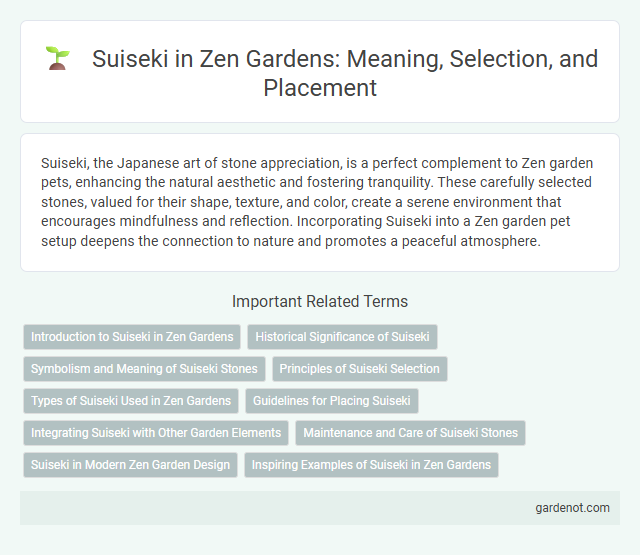Suiseki, the Japanese art of stone appreciation, is a perfect complement to Zen garden pets, enhancing the natural aesthetic and fostering tranquility. These carefully selected stones, valued for their shape, texture, and color, create a serene environment that encourages mindfulness and reflection. Incorporating Suiseki into a Zen garden pet setup deepens the connection to nature and promotes a peaceful atmosphere.
Introduction to Suiseki in Zen Gardens
Suiseki are naturally shaped stones valued for their aesthetic qualities and symbolic representation of natural landscapes in Zen gardens. These stones, often resembling mountains, islands, or animals, are carefully selected and displayed to evoke contemplation and harmony. Suiseki plays a crucial role in enhancing the meditative atmosphere and spiritual depth of Zen garden design.
Historical Significance of Suiseki
Suiseki, the Japanese art of stone appreciation, holds profound historical significance rooted in ancient Chinese scholar's rocks and Zen Buddhism, symbolizing the natural world's harmony and impermanence. These naturally shaped stones embody spiritual and aesthetic values, serving as contemplative aids in Zen gardens to evoke landscapes and inspire meditation. Their historical role reflects a deep cultural tradition of connecting nature with philosophical insights, enriching the overall Zen garden experience.
Symbolism and Meaning of Suiseki Stones
Suiseki stones embody natural landscapes, representing mountains, islands, or waterfalls in miniature form, symbolizing tranquility and the essence of nature. These stones are carefully selected for their shapes, textures, and colors, evoking contemplative states and spiritual reflection in Zen garden settings. Each Suiseki stone serves as a tangible connection to the beauty of the natural world, promoting mindfulness and harmony.
Principles of Suiseki Selection
Suiseki selection relies on principles emphasizing natural beauty, balance, and simplicity, capturing miniature landscapes or natural forms such as mountains, waterfalls, or islands. Stones chosen must exhibit harmony in shape, texture, and color, reflecting the essence of nature without artificial alteration. The ideal suiseki evokes a contemplative mood, encouraging viewers to appreciate its subtle details and spiritual resonance.
Types of Suiseki Used in Zen Gardens
Suiseki in Zen gardens typically includes river stones, mountain stones, and island stones, each symbolizing natural landscapes in miniature form. River stones are smooth and rounded, representing flowing water, while mountain stones have jagged edges that evoke rugged peaks. Island stones, featuring flat surfaces and balanced shapes, symbolize tranquility and stability within the garden's meditative setting.
Guidelines for Placing Suiseki
Suiseki placement in a Zen garden follows precise guidelines emphasizing natural balance and harmony with surrounding elements. Stones should be positioned to mimic natural landscapes, often displayed on wooden bases or trays to highlight their forms and textures without overpowering the overall composition. Attention to asymmetry, scale, and the relationship between stone, water, and plants ensures the Suiseki evokes contemplation and tranquility.
Integrating Suiseki with Other Garden Elements
Integrating Suiseki with other garden elements enhances the meditation experience by harmonizing natural stone art with carefully arranged plants, water features, and sand patterns. Positioning Suiseki near bonsai or within Karesansui (dry landscape gardens) emphasizes balance and natural beauty while creating focal points that reflect landscapes in miniature. Thoughtful placement considers scale, texture, and color to evoke tranquility and deepen the Zen garden's symbolic meaning.
Maintenance and Care of Suiseki Stones
Suiseki stones require regular cleaning with soft brushes and distilled water to prevent dirt buildup and preserve their natural beauty. Avoid using harsh chemicals or abrasive tools that can damage the stone's surface and patina. Proper placement in a Zen garden ensures adequate airflow and reduces moisture accumulation, aiding in long-term preservation.
Suiseki in Modern Zen Garden Design
Suiseki, natural stones appreciated for their shape and texture, play a crucial role in modern Zen garden design by embodying the principles of simplicity and natural beauty. These stones serve as focal points that evoke mountains, islands, or animals, enhancing the garden's meditative ambiance and encouraging quiet contemplation. Integrating Suiseki into contemporary Zen landscapes bridges traditional aesthetics with minimalist trends, creating serene outdoor spaces that promote mindfulness.
Inspiring Examples of Suiseki in Zen Gardens
Suiseki, the Japanese art of stone appreciation, enhances Zen gardens by showcasing naturally weathered stones that evoke landscapes or objects, inspiring contemplation and tranquility. Notable examples include the stone arrangements at Ryoan-ji in Kyoto, where balanced, asymmetrical stones create a serene focal point that mirrors mountain ranges or islands, embodying Zen principles of simplicity and impermanence. These carefully selected and positioned suiseki stones contribute to the garden's meditative atmosphere, encouraging mindfulness and deep connection with nature.
Suiseki Infographic

 gardenot.com
gardenot.com